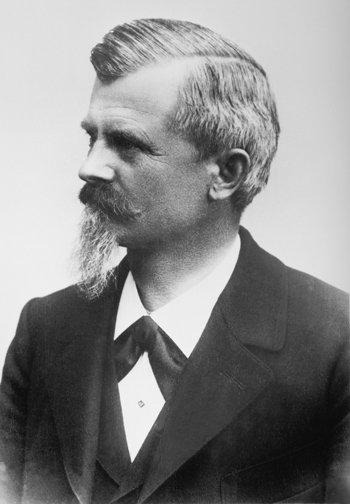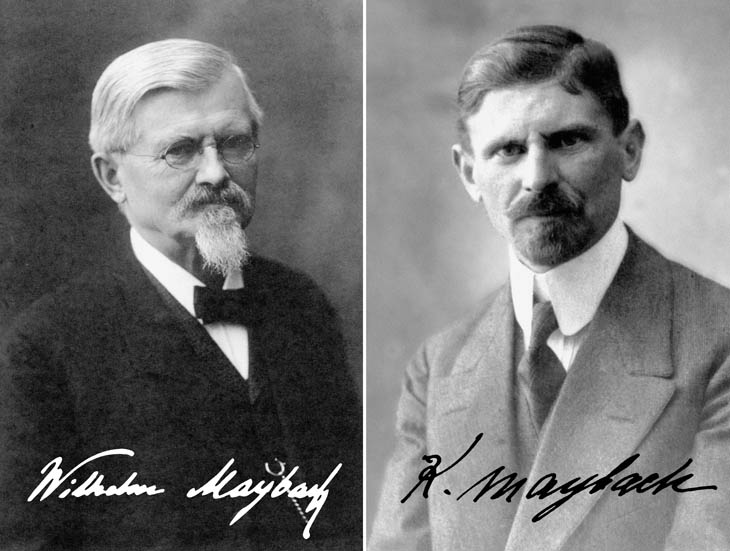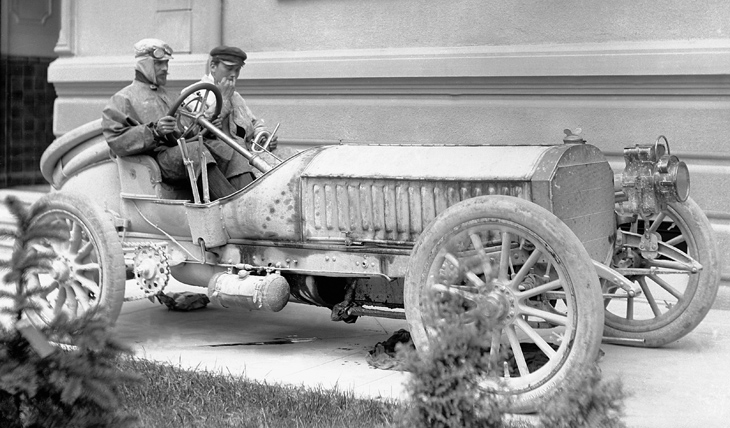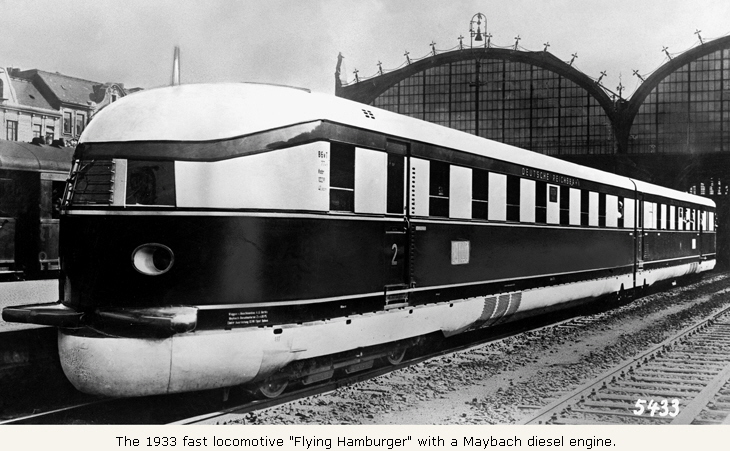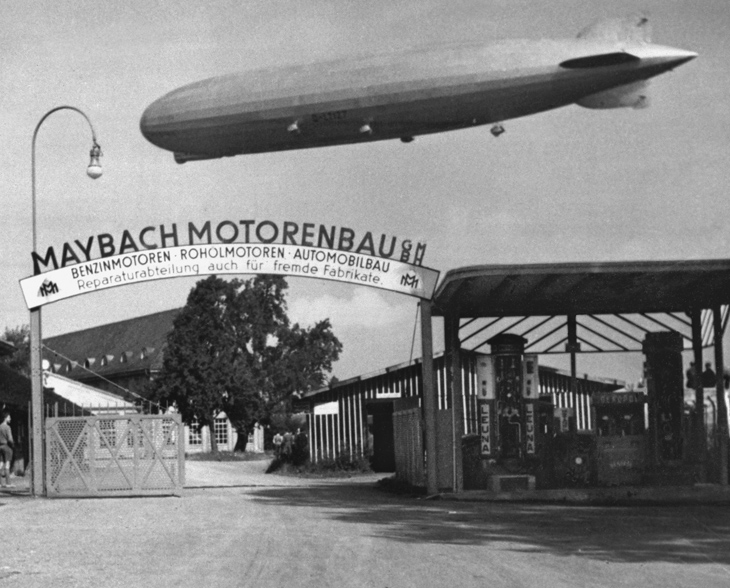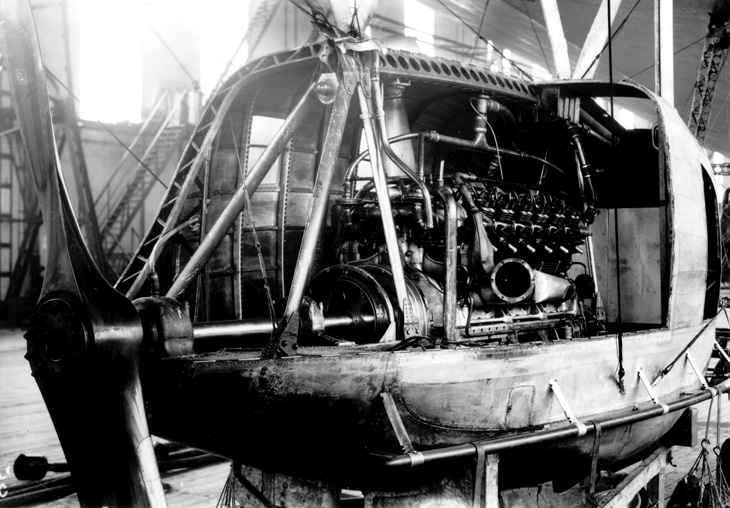|
|
|
|
|
When the Zeppelin LZ 4 was destroyed by strong gusts of wind in 1908 while at anchor for engine repairs, the whole nation rallied round to enable Count Zeppelin to build a new airship. Maybach realised his time had come and presented his son Karl to Zeppelin as a future designer. On 23 March 1909 "Luftfahrzeug-Motorenbau-GmbH" Bissingen was established as a subsidiary of "Luftschiffbau Zeppelin". In 1912 the company moved to premises in Friedrichshafen. Unlike Gottlieb Daimler, Wilhelm Maybach enjoyed a peaceful and richly decorated old age. The King of Württemberg appointed him Royal Chief Engineer of Württemberg, the following year he was awarded an honorary doctorate by the university. The King of Prussia presented him with the Order of the Red Eagle 4th Class and from the Association of German Engineers he received their highest award, the Grashof Memorial Medal. Before his death on 29 December 1929, he was able to witness the unveiling of his son Karl's twelve-cylinder Maybach DS. He was posthumously inducted into the Automotive Hall of Fame, Dearborn in 1996 and in 2004 into the European Automotive Hall of Fame, Geneva.
1909: Maybach sets up his own company
Whether Zeppelin DS 8 or SW 42, between the world wars luxury automobiles of the Maybach brand were among the very best the German motor industry had to offer. These cars were built by Maybach-Motorenbau GmbH, established on 23 March 1909 as Luftfahrzeug-Motorenbau GmbH in Bissingen. Maybach cars ranked high in the public's favour, on a level with prestige cars such as the Mercedes-Benz 770 "Grand Mercedes" and those from Rolls-Royce, Bentley, Isotta-Fraschini and other luxury brands. Today the legendary Maybach trademark, a double M in the shape of an arched triangle, once again stands for luxury cars at the highest level of technology. Since 2002 the Maybach Manufaktur, a unit of Daimler AG, has again been producing exclusive automobiles for this historic brand. The link between the names Daimler and Maybach goes back to the pioneering days of motor vehicle manufacture. Wilhelm Maybach (1846-1929), designer of the first "Mercedes" which appeared in 1901, was probably Gottlieb Daimler's most important collaborator. His innovative ideas enabled the development of the high-speed internal combustion engine that debuted in 1884. In the years that followed, he thought up numerous detailed solutions to advance the motor vehicle from motorised carriage to modern automobile. Aero engines from Lake Constance But Wilhelm Maybach's position at Daimler-Motoren-Gesellschaft (DMG) was weakened after the company founder passed away in 1900. A victim of intrigues, the King of Designers, as he was respectfully called, left DMG in 1907 and on 23 March 1909 founded Luftfahrzeug-Motorenbau GmbH (LMG) in Bissingen, manufacturing drive systems for the airships of Count Zeppelin. The technical director of the new company was Maybach's son Karl (1879-1960), who designed the airship engines himself. Karl Maybach, whose innovations would also shape the future of Maybach brand automobiles and its other products, initially decided in favour of repair-friendly in-line six-cylinder engines. If they malfunctioned in the air, they could be made to run again with tools carried on board the aircraft. Karl Maybach bore responsibility for technical affairs at the company for the most part on his own, but both father and son had stakes in the firm. The biggest shareholder was Luftschiffbau Zeppelin GmbH. How strongly the Maybachs influenced the development of the company is reflected in the name changes. When the company moved to Friedrichshafen in 1912, the Zeppelin subsidiary was called simply Motorenbau GmbH. In 1918, however, it was renamed Maybach-Motorenbau GmbH. Karl Maybach, automotive visionary By the time the company officially took on the name Maybach in 1918, it was son Karl Maybach whose developments represented the brand. In the outgoing 19th/early 20th century, father Wilhelm had made many highly significant inventions that helped ready the automobile for mass production. In the 20th century, his eldest son Karl followed in his footsteps as a design engineer of equal standing. Born on 6 July 1879, the son of Wilhelm and Bertha Maybach was introduced to mechanical engineering as a child: In Deutz, where Karl came into the world, his father worked as chief design engineer in the gas engine factory of Nikolaus Otto. As the Maybachs lived quite close to the factory, Karl soon discovered the drawing offices and production shops as an exciting little world for himself. From Deutz to Lausanne and Oxford by way of Cannstatt When Gottlieb Daimler left Deutz in 1882, Wilhelm Maybach followed him to Cannstatt with his family. Adolf (1884) and Emma (1892), Karl's younger brother and sister, were born in Cannstatt, and Karl Maybach attended intermediate secondary school there until 1897. Karl's father consistently encouraged his interest in all things technical. In line with his talent for mechanical engineering and motor vehicle construction, from 1897 to 1900 Karl gathered practical work experience at Daimler-Motoren-Gesellschaft and Maschinenfabrik Esslingen. He then took up a course of study in mechanical engineering at the Royal Construction Engineering School in Stuttgart, obtaining a diploma in 1902. Then followed a period of employment as a design engineer with Ludwig Loewe & Co. in Berlin and at the Central Office for Scientific and Technological Studies in Potsdam. Finally, Maybach travelled to France and England to further improve his technical skills in Lausanne and Oxford and get practice speaking foreign languages. After returning to Germany, Karl worked at Daimler-Motoren-Gesellschaft as a test engineer and assistant to his father from 1904 to 1906. Inventing for the family honour Working for DMG was a great opportunity for Maybach. At the same time he was forced to witness how his father Wilhelm increasingly suffered from the intrigues spun by the management. His engineering responsibilities were curtailed, his merits were called into question, and new developments came under criticism. One of these new developments was the Daimler six-cylinder racing car, which was developed between 1905 and 1906. This car was the only one that Wilhelm and Karl Maybach ever worked on together. The future automobiles of the Maybach brand were the work of Karl Maybach alone. On the other hand, he always saw his work as a way of acknowledging and rehabilitating his father. In 1906 Karl again changed employers. He moved to Saint-Ouen in France (near Paris), to the Societé d'Atelier de Construction de Comte Henri de Lavalette, to develop a 150 hp (110 kW) car engine. All the time he maintained a professional correspondence by letter with his father. After Wilhelm Maybach left the employ of DMG, the two considered designing a new automobile in cooperation with the Opel works in Rüsselsheim. But then Maybach Sr. became excited about the airships of Count Zeppelin. On 1 November 1909 his son took over the technical direction of Luftfahrzeug-Motorenbau GmbH Bissingen (LMG), the airship engine manufacturing company founded at his father's suggestion. Both Maybachs became shareholders in the new company. 1912: Move to Lake Constance The enterprise set up in Bissingen, meanwhile doing business under the name Motorenbau GmbH, relocated in 1912 to Friedrichshafen to a site close to the Zeppelin dockyard. In May 1918 it was given the name Maybach-Motorenbau; the company logo was a double M inside an arched triangle. The company was forced to give up its focus on aero engines after the First World War – the Treaty of Versailles prohibited the building of such engines by German companies. In response to this incisive restriction, in 1919 Karl Maybach began developing, versatile compact, high-speed diesel engines for a variety of applications, as well as petrol engines for passenger cars. Maybach introduced the first high-speed diesel unit for railways in 1924. These power units were gradually improved for use among other things in the first high-speed rail-coaches of the German Reichsbahn, such as the "Fliegender Hamburger". But the engines also were fitted in ships. Maybach-Motorenbau GmbH (the name of the company since 1918) planned to sell power plants for passenger cars to various car manufacturers in Germany and abroad – following the business model that was applied earlier to drive units for airships and airplanes.
The end of car manufacture All in all, around 1,800 vehicles were produced at Maybach-Motorenbau GmbH in Friedrichshafen. The discontinuation of the SW 42 in the middle of the Second World War put an end – for the time being – to the luxury car brand Maybach after just twenty years. By the time the war ended, around 70 percent of the buildings had been destroyed by bombs and the surviving facilities were in part dismantled by the French occupying forces. From 1947 to 1951 Karl Maybach worked on a tank engine for the French government in the vicinity of Paris. In 1949 Maybach-Motorenbau GmbH in Friedrichshafen resumed development and manufacturing activities, initially making large diesel engines for
ships and trains. After several changes in ownership between 1952 and 1960, in 1966 Maybach-Motorenbau GmbH and Mercedes-Benz Motorenbau GmbH merged to form Maybach With its two divisions Engines and Onsite Energy & Components, the Tognum Group is one of the world's leading suppliers of engines, drive systems and decentralised energy installations. The basis of these products are diesel engines with outputs up to 9,100 kilowatt, gas engines up to 2,000 kilowatt, fuel cells up to 363 kilowatt, and gas turbines up to 50,000 kilowatt. The product portfolio of "Engines" comprises MTU engines and drive systems for ships, heavy land and rail vehicles and military vehicles, and for the oil and gas industry. The portfolio of "Onsite Energy & Components" comprises decentralised energy installations of the MTU Onsite Energy brand, L'Orange injection systems and Rotorion propeller shafts. The energy installations include diesel gensets for emergency, base-load and peak-load power generation as well as block-type power plants for combined heat and power production based on gas engines, fuel cells or gas turbines. However, Mercedes-Benz has also breathed life back into the automotive history of Maybach. In 1997 the Stuttgart brand reinterpreted the tradition of exceptional automobiles from Friedrichshafen with the "Maybach" study of a representative luxury car at the Tokyo Motor Show. Soon the decision was taken to revive Maybach as a brand in its own right within Mercedes-Benz Cars. In 2002 the first new Maybach models, the Maybach 57 and 62, were presented – top-line cars that rightfully bear this great name.
Karl Maybach (1879-1960)
Wilhelm and Karl Maybach are unable to resist the attraction of the new and unexplored. Consequently, following father Wilhelm's departure from the Daimler-Motoren-Gesellschaft in 1907, they decide to seek a future in airship travel, an industry which was still in its infant stages but also enormously popular. This concludes the automotive chapter of Wilhelm and Karl Maybach's lives – for the moment at least. They turn their attention to designing powerplants which are noteworthy for their unparalleled safety and exemplary reliability. They are also contemplating more ambitious projects still, including plans for a jumbo aeroplane to be used for transatlantic flights which is to be manufactured in co-operation with Hellmuth Hirth and Gustav Klein from Bosch. The outbreak of the First World War means that the plans only come to fruition many years later though. Despite the turmoil caused by the war, Karl Maybach remains undeterred. In 1916, he starts to build a house in Friedrichshafen at 21 Zeppelinstraße. Here, he exchanges over 150 letters with his father. All contain detailed explanations of designs, sketches, drawings, problems with engines. They are seldom of a personal nature, in fact Wilhelm Maybach even criticises inaccuracies and careless mistakes: "above mentioned transmission is drawn too hurriedly and not all details of the design are complete," is one of his remarks. Another time he comments, "A matter as serious as transmissions must not be neglected in any way." The world's first high-altitude aircraft engine The admonishing words of the master take root and flourish. In April 1916, Karl Maybach designs the first high-altitude aircraft engine in the world, the "Mb Iva". Throttled back when near to the ground, it only produces full power at altitude, thereby counterbalancing the loss in power caused by the drop in air pressure. The military shows itself to be sceptical though. Karl Maybach's no-nonsense response comes in the spring of 1917, when he constructs an engine test rig on the top of Mount Wendelstein in the Bavarian Alps, a peak 1840 metres in height, and proves the superiority of his engine by means of practical testing. The end of the First World War puts an end to all high-flying projects however: the Treaty of Versailles prohibits the manufacture of aircraft, flying machines or aircraft engines in Germany. Karl Maybach had already suspected this in 1918, and, as head of the company, had acted quickly. Some time later, he outlines the predicament to his father in a letter, "We were forced to look for new fields of business for our factory if we were not to halt manufacture in Friedrichshafen altogether." Return to automotive engineering So, Karl Maybach focuses his attention on cars again. After all, there still remains a great deal to do in this field: at the start of the 1920s, a mere 200,000 passenger cars and commercial vehicles, as well as some 100,000 motorcycles were registered in Germany. And as a car engine had once served as the starting point for Maybach when developing an airship engine, there is no reason why the same formula should not work in reverse. His aim is "to fully develop a first-class petrol-powered vehicle which is suitable for all uses." To allow the first model to be tested out in practice, the W 1, a test car based on a four-seater Mercedes chassis, is built in 1919. Following completion of initial testing, Maybach proceeds to develop the W 2 motor-vehicle engine, featuring six cylinders with a bore of 95 millimetres and a stroke of 135 millimetres. The new engine generates 70 hp at 2200 rpm. Premiere at the 1921 Motor Show The W 2 engine had been specially commissioned and 1000 units ordered for the Dutch luxury car, the Spyker 30/40, manufactured by the Car and Aircraft Factory Trompenburg. The Dutch company runs into financial difficulties though and is not able to purchase all of the engines ordered. This forces Karl Maybach to search for another solution and he decides to build his own cars to use the W 2 engines that have not been sold. The end product is the W 3 (22/70 hp), which is premiered to wide acclaim at the 1921 Motor Show in Berlin. This event establishes Maybach as a luxury brand which exploits all technological possibilities to the full. That is his overriding goal, with Maybach maintaining from the outset that he has no intention of building a "Volkswagen", a car which ordinary people could afford. It is an assertion he reiterates at the Berlin Motor Show: "Ahead of the major show staged by the Association of the German Motor Vehicle Industry in 1921, certain members of the board asked me mockingly if Maybach was going to present the cheapest car of the lot. They were rather upset when I replied: 'No, the most expensive!'" The successes scored after the infant car brand's appearance at the Berlin show provide great stimulus for the team in Friedrichshafen: at the end of 1926, Maybach brings out the W 5 which is equipped with a six-cylinder in-line engine and develops an impressive output of 120 hp from its displacement of 6992 cubic centimetres. This car is later supplied with a sophisticated overdrive transmission (the W 5 SG). Made-to-measure craftsmanship down to the finest detail As an automotive engineer, Karl Maybach is driven by technology in its purest form – in particular the constant development process involved in perfecting a powerful, smooth and durable engine, the invention of new and easy-to-use transmission systems and the optimisation of the suspension. It is something the company's highly discerning customers appreciate when they order the fully assembled, ready-to-drive chassis with frame, suspension, engine, transmission, radiator, firewall and other assemblies for their personal Maybach in Friedrichshafen. When it comes to the car's body, Karl Maybach and his staff only work with the best specialists in the field, firms who are able to meet the requirements of Maybach customers. The fittings and finish are always dictated by the buyers' personal wishes, giving the owners a car very much in their own image. Technical quality, customised design and flawless craftsmanship are the outstanding attributes of the peerless Maybach cars. The body manufacturers complement the superb engineering of the chassis and engine with top-quality fittings worked into the body, itself lovingly hand-crafted. This gives the exclusive clientele carte blanche to have their car tailored to their personal requirements and preferences – in principle, there are no limits to what is possible, except those imposed by the boundaries of the buyer's imagination and their bank balance. The result is automotive works of art, one-off cars of stunning elegance. There are stately limousines, majestic Pullmans, racy two to seven-seater coupés, stylish cabriolets and sporty roadsters. Each boasts exclusive interior specifications, including exquisite leather and fine cloth appointments complemented by selected woods and paintwork, and a host of other refinements. Virtually no two "MM"-badged cars look the same. High-society clientele Well-known personalities are to be found either at the wheel or in the rear of the Maybach cars: politicians and businessmen, princesses and emperors, stars and popular idols, including Enrico Caruso and Max Schmeling. Then there are illustrious figureheads, decorated with titles of nobility, who also have themselves chauffeured around in a Maybach, notably the emperor of Ethiopia, Haile Selassi, King Paul of Greece and the heirs to the Dutch throne, Princess Juliana and Prince Bernard, Prince Esterhazy and the Indian Maharajas of Jaipur, Potila and Kolhapur.
Maybach engines for railcars The industrious designer Karl Maybach is never quite content to stop at engines for motor cars though. As early as 1924, he designs the first fast-running diesel engine including transmission for railcars (peak output of 150 hp at 1300 rpm), thereby triggering off the construction of a special high-speed railcar network in Germany, which is used as a model design the world over. The "Fliegender Hamburger" railcar, which is powered by two Maybach diesel engines, starts service on the route between Hamburg and Berlin in 1933, travelling at speeds of up to 160 km/h. On February 17, 1936 it even sets a world record for standard-specification railcars, attaining a speed of 205 km/h. Maybach also has a hand in the construction of the first airship to be built after the end of the First World War in Friedrichshafen. He supplies the five twelve-cylinder engines for the LZ 126, which deliver a total output of 2850 hp. The colossal zeppelin is flown to the USA in October 1924 as a form of reparation payment. Their high power makes the Maybach engines ideal for use in commercial vehicles, buses and coaches, as well as military vehicles. In fact, the military is so impressed by the high performance, that they eventually commission drive units for tracked vehicles to be built in Friedrichshafen. Despite feeling somewhat uneasy about providing engines to motorise military vehicles, ultimately Karl Maybach is not a politically-minded person: he sees himself as "just" a designer, and pays little attention to the political goings-on around him.
Contract from the French government Following the Second World War, the French soon come to a similar conclusion. They admire his technical expertise and offer him a contract to build high-performance engines for France. Karl Maybach consents, under the proviso that engine production can still continue in Friedrichshafen. On September 12, 1946, he signs a contract with the French government for the preparatory study and manufacture of a 1000-hp petrol-powered engine and a diesel power unit. As he is able to work, he is happy to move to the French town of Vernon, close to Paris, where he also celebrates his 70th birthday on July 6, 1949. In mid-1951, Karl Maybach returns to Germany, where he lives and works in his house in Garmisch, leaving his post at the company at his own request on December 19, 1952. He is still a regular visitor to the company headquarters though – it is during one of these visits that the maestro of design dies on February 6, 1960. LZ 127 over the main entrance to Maybach Motorenbau in Friedrichshafen (1935).
The joint venture with Zeppelin airship construction In April 1907 Maybach left Daimler-Motoren-Gesellschaft and teamed up with his son Karl to continue working on his own designs. He struck up contact with Graf Ferdinand von Zeppelin and convinced him that the engines he had developed together with Karl would also be perfect for powering airships. This led to the two men establishing "Luftfahrzeug-Motorenbau GmbH" in Bissingen, near Stuttgart in 1909, as a subsidiary of the Zeppelin foundation and with Karl Maybach appointed technical director. The maiden flight of the first Zeppelin powered by a Maybach engine took place in May 1910. The company relocated to Friedrichshafen on the banks of Lake Constance in 1912, and moved in next-door to Zeppelin's airship construction plant. This was one of the early joint ventures. In the years after the First World War, however, there was a ban on the production of engines for airplanes or airships in Germany. This was when Maybach turned his attentions to car engines, both as an alternative venture in economic terms and as a challenge to himself from a design perspective. Maybach engine of the airship LZ 126 (1924)
Maybach engine in the airship LZ 127 (1927).
|
|
Home < Mercedes-Benz < Mercedes-Benz Cars < Historical Models < History
|
